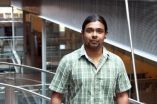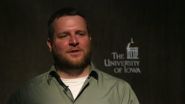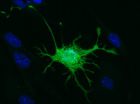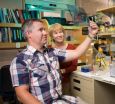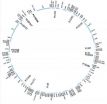(Press-News.org) Tracing where your DNA was formed over 1,000 years ago is now possible due to a revolutionary technique developed by a team of international scientists led by experts from the University of Sheffield.
The ground breaking Geographic Population Structure (GPS) tool, created by Dr Eran Elhaik from the University of Sheffield's Department of Animal and Plant Sciences and Dr Tatiana Tatarinova from the University of Southern California, works similarly to a satellite navigation system as it helps you to find your way home, but not the one you currently live in – but rather your actual ancestor's home from 1,000 years ago.
Previously, scientists have only been able to locate where your DNA was formed to within 700kms, which in Europe could be two countries away; however this pioneering technique has been 98 per cent successful in locating worldwide populations to their right geographic regions, and down to their village and island of origin.
The breakthrough of knowing where the gene pools that created your DNA were last mixed has massive implications for life-saving personalised medicine, advancing forensic science and for the study of populations whose ancestral origins are under debate, such as African Americans, Roma gypsies and European Jews.
Genetic admixture occurs when individuals from two or more previously separated populations begin interbreeding. This results in the creation of new gene pools representing a mixture of the founder gene pool.
Such processes are extremely common in history during migrations and invasions, for example, when the Vikings invaded Britain and Europe in the 11th Century and settled with locals some of them formed a new Viking-Anglo-Saxon gene pool, but some married other Vikings and maintained their original gene pool, allowing GPS to trace their Scandinavian origins.
Dr Eran Elhaik said: "If we think of our world as being made up of different colours of soup – representing different populations - it is easy to visualise how genetic admixture occurs. If a population from the blue soup region mixes with a population from the red soup region their off-springs would appear as a purple soup.
"The more genetic admixture that takes place, the more different colours of soup are introduced which makes it increasingly difficult to locate your DNA's ancestry using traditional tools like Spatial Ancestry analysis (SPA) which has an accuracy level of less than two per cent."
He added: "What we have discovered here at the University of Sheffield is a way to find not where you were born – as you have that information on your passport – but where your DNA was formed up to 1,000 years ago by modelling these admixture processes.
"What is remarkable is that, we can do this so accurately that we can locate the village where your ancestors lived hundreds and hundreds of years ago – until now this has never been possible."
To demonstrate how accurate GPS predictions are, Dr Elhaik and his colleagues analysed data from 10 villages in Sardinia and over 20 islands in Oceania. The research published today in the journal Nature Communications shows that Dr Elhaik and his team were able to place a quarter of the residents in Sardinia directly to their home village and most of the remaining residents within 50km of their village. The results for Oceania were no less impressive with almost 90 per cent success of tracing islanders exactly to their island.
"This is a significant improvement compared to the alternative SPA tool that placed Oceanians in India," said Elhaik.
"In his third book, children's author L. Frank Baum revealed that Oz resided around Australia. It always troubled me that if I ever met anyone claiming to be from the wonderful world of Oz, I would like to be able to verify their origins and now we can!
"This technique also means that we can no longer easily classify people's ethnic identities with one single label. It is impossible for any of us to tick one box on a form such as White British or African as we are much complex models with our own unique identities. The notion of races is simply not plausible."
Tracing our ancestry is now a major social trend and genealogy is the number one hobby in America. An estimated one million people in the USA have already had their DNA genotyped. People can explore their DNA by simply taking a swab from inside their mouth and sending it to a company such as 23andme or ancestry.com for costs ranging from $99-$200.
Dr Elhaik's co-author, Dr Tatiana Tatarinova, developed a website making GPS accessible to the public.
"To help people find their roots, I developed a website that allows anyone who has had their DNA genotyped to upload their results and use GPS to find their ancestral home," said Dr Tatarinova, who is also an Associate Professor of Research Paediatrics at the Keck School of Medicine of the University of Southern California.
"We were surprised by the simplicity and precision of this method. People in a given geographical area are more likely to have similar genetics. When they also have genetic traits typically found in other, distant regions, the geographical origin of those traits is generally the closest location where those traits can be found."
According to the researchers, in ethnically-diverse regions like the UK or US, where many people know only a few generations of their descendants, this kind of screening has huge, important medical implications.
Discovery of a certain genotype might indicate the potential for a genetic disease and suggest that diagnostic testing be done. Also, as scientists learn more about personalized medicine, there is evidence that specific genotypes respond differently to medications—making this information potentially useful when selecting the most effective therapy and appropriate dosage. The investigators are currently designing a study to correlate pharmacokinetics - the time course of drug metabolism - with genotype.
INFORMATION:
Geographic Population Structure can locate the village your ancestors lived 1,000 years ago.
Breakthrough has massive implications for life-saving personalised treatment.
Previous tools were only accurate to within 700km.
Notes for Editors
To watch the GPS video please visit https://www.youtube.com/watch?v=Aap-s1kle4Q
For more information about the GPS tool visit http://www.prosapiagenetics.com/
To view the paper in full visit http://www.nature.com/ncomms/2014/140429/ncomms4513/full/ncomms4513.html
University of Sheffield
With almost 25,000 of the brightest students from around 120 countries, learning alongside over 1,200 of the best academics from across the globe, the University of Sheffield is one of the world's leading universities.
A member of the UK's prestigious Russell Group of leading research-led institutions, Sheffield offers world-class teaching and research excellence across a wide range of disciplines.
Unified by the power of discovery and understanding, staff and students at the university are committed to finding new ways to transform the world we live in.
In 2011 it was named University of the Year in the Times Higher Education Awards and in the last decade has won four Queen's Anniversary Prizes in recognition of the outstanding contribution to the United Kingdom's intellectual, economic, cultural and social life.
Sheffield has five Nobel Prize winners among former staff and students and its alumni go on to hold positions of great responsibility and influence all over the world, making significant contributions in their chosen fields.
Global research partners and clients include Boeing, Rolls-Royce, Unilever, AstraZeneca, Glaxo SmithKline and Siemens, as well as many UK and overseas government agencies and charitable foundations.
For further information, please visit http://www.sheffield.ac.uk
For further information please contact: Amy Pullan, Media Relations Officer, on 0114 222 9859 or email a.l.pullan@sheffield.ac.uk
To read other news releases about the University of Sheffield, visit http://www.sheffield.ac.uk/news
Ground breaking technique offers DNA 'Sat Nav' direct to your ancestor's home 1,000 years ago
Geographic Population Structure can locate the village your ancestors lived 1,000 years ago
2014-04-30
ELSE PRESS RELEASES FROM THIS DATE:
Cutting cancer to pieces: New research on bleomycin
2014-04-30
A variety of cancers are treated with the anti-tumor agent bleomycin, though its disease-fighting properties remain poorly understood.
In a new study, lead author Basab Roy—a researcher at Arizona State University's Biodesign Institute—describes bleomycin's ability to cut through double-stranded DNA in cancerous cells, like a pair of scissors. Such DNA cleavage often leads to cell death in particular types of cancer cells.
The paper is co-authored by professor Sidney Hecht, director of Biodesign's Center for BioEnergetics. The study presents, for the first time, alternative ...
Infertile women want more support
2014-04-30
VIDEO:
University of Iowa Communication Studies researchers Keli Steuber and Andrew High talk about infertility.
Click here for more information.
Many women coping with infertility count on relatives or close friends for encouragement and assistance. But according to research at the University of Iowa, when it comes to support, women may not be receiving enough—or even the right kind.
"Infertility is a more prevalent issue than people realize. It affects one in six couples, ...
Stem cells from teeth can make brain-like cells
2014-04-30
University of Adelaide researchers have discovered that stem cells taken from teeth can grow to resemble brain cells, suggesting they could one day be used in the brain as a therapy for stroke.
In the University's Centre for Stem Cell Research, laboratory studies have shown that stem cells from teeth can develop and form complex networks of brain-like cells. Although these cells haven't developed into fully fledged neurons, researchers believe it's just a matter of time and the right conditions for it to happen.
"Stem cells from teeth have great potential to grow into ...
Salk Institute study identifies novel regulator of key gene expression in cancer
2014-04-30
LA JOLLA—Scientists at the Salk Institute for Biological Studies have identified a key genetic switch linked to the development, progression and outcome of cancer, a finding that may lead to new targets for cancer therapies.
The switch, a string of nucleotides dubbed a long non-coding RNA (lncRNA), does not code for proteins like regular RNA. Instead, the scientists found, this particular lncRNA acts as an on/off switch for a key gene whose excessive activity is tied to inflammation and cancer, COX-2.
The COX-2 gene mediates inflammation, which in most cases helps our ...
New revolutionary sensor links pressure to color change
2014-04-30
RIVERSIDE, Calif. — Imagine an automobile crash test that uses test dummies painted all over with a substance that can change color according to the levels of stress that various parts of the dummies' bodies will endure. Such a "color map" could provide vital information to engineers designing safer automobiles.
Or imagine baseball gloves that when worn show the batters if they are using the appropriate amount of pressure to grip their bats, resulting in better performance.
New technology developed at the University of California, Riverside may now make the above and ...
EARTH Magazine: Precise to a fault: How GPS revolutionized seismic research
2014-04-30
Alexandria, Va., - Global Positioning System (GPS) technology was conceived in the 1960s to provide precise time and location data to the U.S. military, but it was soon embraced by geodesists and earth scientists. The first major test of GPS as a seismic tool occurred on Oct. 17, 1989, when the Loma Prieta earthquake struck San Francisco just as the third game of the World Series was about to begin at Candlestick Park. The quake killed 63 people, injured several thousand and caused an estimated $6 billion in damage.
Prior to the quake, geoscientists had placed GPS markers ...
Simple sequence repeats for population-level studies of pines
2014-04-30
Simple sequence repeats, abbreviated SSRs and frequently referred to as microsatellites, are highly variable sections of the genome. 'Sequence repeat' refers to the fact that a nucleotide motif is repeated. 'Simple,' because the repeated sequence often consists of only a couple of nucleotides—for example, ATAT.
Because these markers typically have high rates of molecular evolution, the number of repeats present in the genome often differs between individuals. By isolating SSRs and comparing length differences between taxa, evolutionary relationships can be inferred. Their ...
Regenerative medicine approach improves muscle strength, function in leg injuries
2014-04-30
PITTSBURGH, April 30, 2014 – Damaged leg muscles grew stronger and showed signs of regeneration in three out of five men whose old injuries were surgically implanted with extracellular matrix (ECM) derived from pig bladder, according to a new study conducted by researchers at the University of Pittsburgh School of Medicine and the McGowan Institute for Regenerative Medicine. Early findings from a human trial of the process and from animal studies were published today in Science Translational Medicine.
When a large volume of muscle is lost, typically due to trauma, the ...
Frozen meal eaters get more vegetables including greens, beans and whole grains but with lower total calories vs. fast food restaurant eaters
2014-04-30
SAN DIEGO (April 30, 2014) – New analysis of data from the 2003-2010 What We Eat In America (WWEIA) National Health and Nutrition Examination Survey (NHANES), a program of the Centers for Disease Control and Prevention (CDC), indicates that consumers of frozen meals (1) compared to consumers of quick service restaurant (QSR) meals (2) had lower calorie intakes and better Healthy Eating Index (HEI) score. In fact, the analysis revealed that those who consumed frozen meals consumed 253 fewer calories than those who consumed a quick service restaurant meal.
These results ...
Competition for ecological niches limits the formation of new species
2014-04-30
The rate at which new species evolve is limited by competition for ecological niches, report scientists from the University of Chicago in Nature on April 30. The study, which analyzes the evolutionary and genetic relationships between all 461 songbird species that live in the Himalayan mountains, suggests that as ecological niches within an environment are filled, the formation of new species slows or even stops.
To study what controls the process of speciation, Trevor Price, PhD, professor of ecology and evolution at the University of Chicago, Dhananjai Mohan of the ...
LAST 30 PRESS RELEASES:
How cells balance their protein levels
Nirsevimab vs RSVpreF vaccine for RSV–related hospitalization in newborns
Effectiveness and impact of maternal RSV immunization and nirsevimab on medically attended RSV in US children
AI gives scientists a boost, but at the cost of too many mediocre papers
Next-generation vision model maps tree growth at sub-meter precision
Genes aren’t destiny for inherited blindness, study shows
MIT study: High-fat diets make liver cells more likely to become cancerous
Exposure to multiple fine particulate matter components and incident depression in the US Medicare population
Risk of burdensome health care spending over time in the US
Nirsevimab against hospitalizations and emergency department visits for lower respiratory tract infection in infants
New microfluidics technology enables highly uniform DNA condensate formation
A new strategy for immune tolerance
Super Mario Bros. help fight burnout: New study links classic games to boosted happiness
Deepest gas hydrate cold seep ever discovered in the arctic: International research team unveils Freya Hydrate Mounds at 3,640 m depth.
Integrating light and structure: Smarter mapping for fragile wetland ecosystems
ACA-SIM: A robust way to decode satellite signals over complex waters
Probiotics can restore gut microbiome in breastfed infants
AI could help predict nutrition risks in ICU patients, study finds
Federal EITC has unexpected result, researchers say – it decreases domestic violence
Researchers identify gene that calms the mind and improves attention in mice
Artificial metabolism turns waste CO2 into useful chemicals
Ancient sea anemone sheds light on animal cell type evolution
Begging gene leads to drone food
How climate policies that incentivize and penalize can drive the clean energy transition
Can community awareness campaigns in low-resource areas improve early diagnosis of colorectal cancer?
Stardust study resets how life’s atoms spread through space
Practical education: Clinical scenario-based program development
The impact of family dynamics on eating behaviour – how going home for Christmas can change how you eat
Tracing the quick synthesis of an industrially important catalyst
New software sheds light on cancer’s hidden genetic networks
[Press-News.org] Ground breaking technique offers DNA 'Sat Nav' direct to your ancestor's home 1,000 years agoGeographic Population Structure can locate the village your ancestors lived 1,000 years ago
